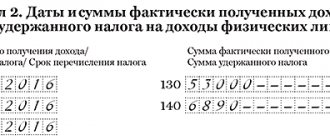Accrual of interest on deposits and issued loans - non-operating income
Every entrepreneur, when organizing his own business, strives for a single goal - to make a profit. But for this you need to generate some income. Income can be received from the sale of products of own production, goods previously purchased for the purpose of resale, as well as from the performance of work and the provision of services. This concerns the main activity of an economic entity.
But there is another type of income. Thus, an individual entrepreneur or organization can open a deposit account with a banking institution in order to receive additional funds in the form of accrued interest on the balance of this account. Additional income can also be obtained by issuing funds to other economic entities and charging the borrower interest for use. Accrued interest receivable on both deposits and loans issued will constitute so-called non-operating income, which must subsequently be taken into account when calculating income tax.
In the income tax return, the amounts of accrued interest receivable will be included in line 100 of Appendix 1 to Sheet 02.
What about the VAT return? Are the specified non-operating incomes included in it?
Starting from the report for the 4th quarter of 2021, it is necessary to use a new VAT declaration form, approved. by order of the Federal Tax Service dated August 19, 2020 No. ED-7-3/ [email protected]
How to reflect VAT on interest in the VAT return
The line “Tax amounts subject to recovery when carrying out transactions taxed at a tax rate of 0 percent” must be filled out if you previously purchased goods (work, services) and legally accepted VAT for deduction, and in the past quarter you sold these goods for export and did not confirm him in the same quarter. 38.
For example, in the first quarter you accepted VAT for deduction on purchased goods and reflected it on line 130 of section 3 of the VAT return. 38.8 Procedure for filling out the declaration for the first quarter. And in the second quarter, these goods were shipped for export. Then the amount of VAT related to the export transaction and previously reflected on line 130 must be restored by reflecting it on line 100 of Section 3.
https://www..com/watch{q}v=ytcreatorsru
The question of in what period the tax should be restored is controversial, but the Ministry of Finance believes that during the period of shipment of goods for export, Letter of the Ministry of Finance of Russia dated April 28, 2008 No. 03-07-08/103.
Once you have shipped goods for export, carefully monitor compliance with the deadlines associated with the confirmation of export transactions for each shipment. After all, if you miss the deadline, you will be charged additional VAT, as well as penalties and a fine. True, even after this you can collect the necessary documents and, having confirmed the validity of applying the 0% rate, return the tax paid.
And remember that if documents confirming the right to deduct input VAT on domestic transactions may, in principle, never be checked, then when refunding VAT on exports, tax authorities have the right to request all documents for deductions during a desk audit of the declaration. 8 tbsp. 88 Tax Code of the Russian Federation.
The quarterly VAT return contains two sections that must be completed:
- head (title page);
- the amount of VAT to be paid to the budget/refunded from the budget.
A reporting document with a simplified format (Title and Section 1 with dashes added) is submitted in the following cases:
- carrying out business transactions that are not subject to VAT during the reporting period;
- conducting activities outside Russian territory;
- the presence of production/commodity operations of a long period - when the final completion of work requires more than six months;
- a commercial entity applies special taxation regimes (Unified Agricultural Tax, UTII, PSN, simplified taxation system);
- when issuing an invoice with a dedicated tax by a taxpayer exempt from VAT.
If the specified prerequisites are present, sales amounts for preferential types of activities are entered in section 7 of the declaration.
Section 2 – calculated VAT amounts for organizations/individual entrepreneurs having the status of tax agents;
Section 3 – sales amounts subject to taxation;
Sections 4,5,6 - are used when there are business transactions with a zero tax rate or do not have a confirmed “zero” status;
Section 7 – data on transactions exempt from VAT are indicated;
Sections 8 – 12 include a summary of information from the purchase book, sales book and invoice journal and are completed by all VAT payers applying tax deductions.
The reporting regulations for VAT must comply with the requirements of the instructions of the Ministry of Finance and the Federal Tax Service, set out in order No. ММВ-7-3/558 dated October 29, 2014.
Title page
The procedure for filling out the main sheet of the VAT return does not differ from the rules established for all types of reporting to the Federal Tax Service:
- Information about the payer’s TIN and KPP is written at the top of the sheet and does not differ from the information in the registration documents;
- The tax period is indicated by the code used for tax reporting. The decoding of the codes is indicated in Appendix No. 3 to the Instructions for filling out the Declaration.
- Tax inspectorate code - the declaration is submitted to the division of the Federal Tax Service where the payer is registered. Accurate information about all codes of territorial tax authorities is published on the Federal Tax Service website.
- The name of the business entity corresponds exactly to the name specified in the constituent documentation.
- OKVED code - the main type of activity according to the statistical code is indicated on the title page. The indicator is indicated in the Rosstat information letter and in the Unified State Register of Legal Entities extract.
- Contact phone number, number of completed and submitted declaration sheets and applications.
The signature of the payer’s representative and the date of generation of the report are affixed to the title page. On the right side of the sheet there is space for confirming records of the authorized person of the tax service.
Section 1
Section 1 is the final section in which the VAT payer reports the amounts subject to payment or reimbursement based on the results of accounting/tax accounting and information from section 3 of the declaration.
The sheet must indicate the code of the territorial entity (OKTMO) where the taxpayer operates and is registered. Line 020 records the KBK (budget classification code) for this type of tax. VAT payers are guided by the KBK for standard activities -001 1000 110. The KBK can be clarified in the latest edition of Order of the Ministry of Finance No. 65n dated 07/01/2013.
Attention: if the BCC is inaccurately indicated in the VAT return, the tax paid will not be credited to the taxpayer’s personal account and will be deposited in the accounts of the Federal Treasury until the identity of the payment is clarified. A penalty will be charged for late tax payment.
Line 030 is filled in only if the invoice is issued by a preferential taxpayer exempt from VAT.
In lines 040 and 050 you should record the amounts received for tax calculation. If the result of the calculation is positive, then the amount of VAT payable is indicated in line 040; if the result is negative, the result is recorded in line 050 and is subject to reimbursement from the state budget.
Section 2
This section is required to be completed by tax agents for each organization for which they have this status. These may be foreign partners who do not pay VAT, lessors and sellers of municipal property.
For each counterparty, a separate sheet of Section 2 is filled out, where its name, INN (if any), BCC and transaction code must be indicated.
When reselling confiscated goods or carrying out trade transactions with foreign partners, tax agents fill out lines 080-100 of Section 2 - the amount of shipment and the amounts received as an advance payment.
The total amount payable by the tax agent is reflected in line 060, taking into account the values entered in the following lines - 080 and 090. The amount of tax deduction for realized advances (p.
100) reduces the final VAT amount.
We invite you to familiarize yourself with: Sample application for non-payment of wages
Section 3
The main section of VAT reporting, in which taxpayers calculate the tax payable/reimbursable at the rates provided by law, raises the most questions among accountants. Sequential filling of section lines looks like this:
- Lines 010-040 reflect the amount of revenue from sales (based on shipment), taxed, respectively, at the applicable tax and settlement rates. The amount recorded in these lines must be equal to the amount of income recorded in account 90.1 and shown in the calculation of income tax. If discrepancies are found in the indicators in the declarations, the fiscal authorities will request explanations.
- Page 050 is filled in in a special case - when an organization is sold as a complex of accounting assets. The tax base in this case is the book value of the property multiplied by a special adjustment indicator.
- Page 060 concerns production and construction organizations carrying out construction and installation work for their own needs. This line reproduces the cost of the work performed, which includes all actual costs incurred during construction or installation.
- Page 070 – in the column “Tax base” in this line you should enter the amount of all cash receipts received on account of upcoming deliveries. The VAT amount is calculated at the rate of 18/118 or 10/110, depending on the type of goods/services/work. If the sale occurs within 5 days after the prepayment “falls” into the current account, then this amount is not indicated in the declaration as an advance received.
In section 3 it is necessary to enter the VAT amounts, which, in accordance with the requirements of paragraph 3 of Article 170 of the Tax Code, must be restored in tax accounting.
This applies to amounts previously declared as tax deductions on preferential grounds - the use of a special regime, exemption from VAT. The restored tax amounts are reflected in total on p.
080, with specification on lines 090 and 100.
In lines 105-109, data on the adjustment of VAT amounts in accounting during the reporting period is entered. This may be the erroneous application of a reduced tax rate, the wrongful classification of transactions as non-taxable, or the inability to confirm a zero rate.
The total amount of accrued VAT is indicated in line 110 and consists of the sum of all indicators reflected in column 5 of lines 010-080, 105-109. The final tax figure should be equal to the amount of VAT in the sales book based on the total turnover for the reporting quarter.
Lines 120-190 (column 3) are devoted to deductions that require the amount of VAT to be paid:
- The amount of deductions on line 120 is formed on the basis of invoices received from counterparties-suppliers and is equal to the amount of VAT in the purchase book.
- Line 130 is filled in similar to page 070, but contains data on the amount of tax paid to the supplier as an advance payment.
- Line 140 duplicates line 060 and reflects the tax calculated from the amount of actual costs when carrying out construction and installation work for the needs of the taxpayer.
- Lines 150 – 160 relate to foreign trade activities and amount to VAT paid at customs or accrued on the cost of goods imported into Russia from the Customs Union countries.
- In line 170 it is necessary to indicate the amount of VAT previously accrued on advances received if sales occurred in the reporting quarter.
- Line 180 is filled in by tax agents and contains the VAT amount indicated in line 060 of Section 2.
Deposit interest and VAT reporting: how they are related
By placing funds in a deposit account of a banking institution, the business entity remains their owner. The money must be returned by the bank upon expiration of the agreement. In accordance with Art. 39 of the Tax Code of the Russian Federation, such an operation is not recognized as a sale. This means that interest accrued on the deposit is not subject to VAT, like amounts not related to sales. This is precisely the opinion expressed by officials of the Ministry of Finance in letter dated 10/04/2013 No. 03-07-15/41198.
Thus, interest on deposit agreements does not need to be included in the VAT report.
Interest on deposit
The placement of funds in a deposit account with a credit institution is drawn up on the basis of a bank deposit agreement and is regulated by the norms of Chapter 44 of the Civil Code of the Russian Federation “Bank Deposit”.
According to the bank deposit agreement, one party - the Bank - accepts from the second party - the depositor - a certain amount of money. After the end of the term of the bank deposit, the bank undertakes to return the entire amount of the deposit, as well as pay interest as provided for in the agreement.
The funds placed on deposit are not the property of the bank. The bank cannot dispose of them at its own discretion. Funds are kept in a special deposit account throughout the contract.
Receiving interest on a deposit is not related to the sale of goods, works or services. Placing funds in a deposit account is not a sale.
According to clause 3 of Article 149 of the Tax Code of the Russian Federation, interest received on a deposit is not subject to VAT.
Consequently, accrued interest is not reflected in the VAT return and invoices are not generated. There is no separate accounting of “input” VAT.
Interest on the deposit relates to unrealized income, and therefore must be reflected in the income tax return.
There are two methods for calculating interest:
- Accrual method - if with this method the term of the deposit agreement comes for more than one reporting period, then, according to clause 6 of Article 271 and clause 8 of Article 328 of the Tax Code of the Russian Federation, interest, which is considered to be unrealized income, must be taken into account at the end of the month, each tax reporting period. In fact, according to this method, when interest on the deposit is received does not matter. Also, regardless of when interest was accrued, they must be reflected in the income tax return;
- Cash method - with this method, interest on the deposit is taken into account at the time it is credited to the account, and must also be reflected in the income tax return.
Important!!! If the taxpayer received accrued interest on a deposit in the reporting (tax) period, then the data on the Income Tax Return and the data on the VAT Return will not match, since the interest received on the deposit is reflected in the Income Tax Return, and not in VAT declarations.
| ★ Best-selling book “Accounting from scratch” for dummies (understand how to do accounting in 72 hours) > 8,000 books purchased |
Reflection of interest on loans issued in the VAT return
The situation is somewhat different with the interest that the lender accrues to the borrower when issuing loans in the form of cash.
According to sub. 15 clause 3 art. 149 of the Tax Code of the Russian Federation, the accrual of these interests is an operation exempt from VAT. It is for such operations that the tax report provides for Section 7, which contains four columns filled in as follows:
- column 1 - code 1010292 is given, designated “Loan operations in cash and securities, including interest on them...”;
- column 2 - the amount of accrued interest receivable is recorded;
- Columns 3 and 4 are crossed out.
According to paragraph 3 of Art. 169 of the Tax Code of the Russian Federation, the lender does not need to issue invoices for the amount of interest accrued under loan agreements.
When simultaneously carrying out transactions that are subject to VAT and exempt from this tax, the taxpayer must maintain separate accounting, the principles of which must be outlined in the accounting policy.





